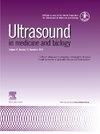鉴别透明细胞和非透明细胞肾细胞癌:使用对比增强超声放射组学的机器学习方法。
IF 2.6
3区 医学
Q2 ACOUSTICS
引用次数: 0
摘要
目的:本研究的目的是评估使用对比增强超声(CEUS)放射组学的机器学习模型在鉴别透明细胞肾细胞癌(ccRCC)和非ccRCC方面的临床应用价值。方法:292例经病理证实的RCC亚型患者行超声造影(发展组)。N = 231;验证集,n = 61)在回顾性研究中。放射组学特征来源于皮质期和实质期获得的超声造影图像。放射组学模型使用逻辑回归(LR)、支持向量机、决策树、朴素贝叶斯、梯度增强机和随机森林建立。根据接收机工作特性曲线下面积(AUC)确定合适的模型。通过单变量和多变量LR分析确定适当的临床超声造影特征以建立临床模型。结合放射组学和临床超声造影特征,建立联合模型。对模型的性能进行了综合评价。结果:经过对2250个放射组学特征的还原和选择过程,最终的8个特征集被认为是有价值的。其中LR模型在验证集上的性能最高,具有较好的鲁棒性。在开发集和验证集中,放射组学模型(AUC, 0.946和0.927)和联合模型(AUC, 0.949和0.925)均优于临床模型(AUC, 0.851和0.768),AUC值更高(均p < 0.05)。联合模型具有良好的校正效果和临床效益。结论:综合临床超声造影和超声造影放射组学特征的联合模型在鉴别ccRCC和非ccRCC方面具有良好的诊断效果。本文章由计算机程序翻译,如有差异,请以英文原文为准。
Discriminating Clear Cell From Non-Clear Cell Renal Cell Carcinoma: A Machine Learning Approach Using Contrast-enhanced Ultrasound Radiomics
Objective
The aim of this investigation is to assess the clinical usefulness of a machine learning model using contrast-enhanced ultrasound (CEUS) radiomics in discriminating clear cell renal cell carcinoma (ccRCC) from non-ccRCC.
Methods
A total of 292 patients with pathologically confirmed RCC subtypes underwent CEUS (development set. n = 231; validation set, n = 61) in a retrospective study. Radiomics features were derived from CEUS images acquired during the cortical and parenchymal phases. Radiomics models were developed using logistic regression (LR), support vector machine, decision tree, naive Bayes, gradient boosting machine, and random forest. The suitable model was identified based on the area under the receiver operating characteristic curve (AUC). Appropriate clinical CEUS features were identified through univariate and multivariate LR analyses to develop a clinical model. By integrating radiomics and clinical CEUS features, a combined model was established. A comprehensive evaluation of the models’ performance was conducted.
Results
After the reduction and selection process were applied to 2250 radiomics features, the final set of 8 features was considered valuable. Among the models, the LR model had the highest performance on the validation set and showed good robustness. In both the development and validation sets, both the radiomics (AUC, 0.946 and 0.927) and the combined models (AUC, 0.949 and 0.925) outperformed the clinical model (AUC, 0.851 and 0.768), showing higher AUC values (all p < 0.05). The combined model exhibited favorable calibration and clinical benefit.
Conclusion
The combined model integrating clinical CEUS and CEUS radiomics features demonstrated good diagnostic performance in discriminating ccRCC from non-ccRCC.
求助全文
通过发布文献求助,成功后即可免费获取论文全文。
去求助
来源期刊
CiteScore
6.20
自引率
6.90%
发文量
325
审稿时长
70 days
期刊介绍:
Ultrasound in Medicine and Biology is the official journal of the World Federation for Ultrasound in Medicine and Biology. The journal publishes original contributions that demonstrate a novel application of an existing ultrasound technology in clinical diagnostic, interventional and therapeutic applications, new and improved clinical techniques, the physics, engineering and technology of ultrasound in medicine and biology, and the interactions between ultrasound and biological systems, including bioeffects. Papers that simply utilize standard diagnostic ultrasound as a measuring tool will be considered out of scope. Extended critical reviews of subjects of contemporary interest in the field are also published, in addition to occasional editorial articles, clinical and technical notes, book reviews, letters to the editor and a calendar of forthcoming meetings. It is the aim of the journal fully to meet the information and publication requirements of the clinicians, scientists, engineers and other professionals who constitute the biomedical ultrasonic community.

 求助内容:
求助内容: 应助结果提醒方式:
应助结果提醒方式:


